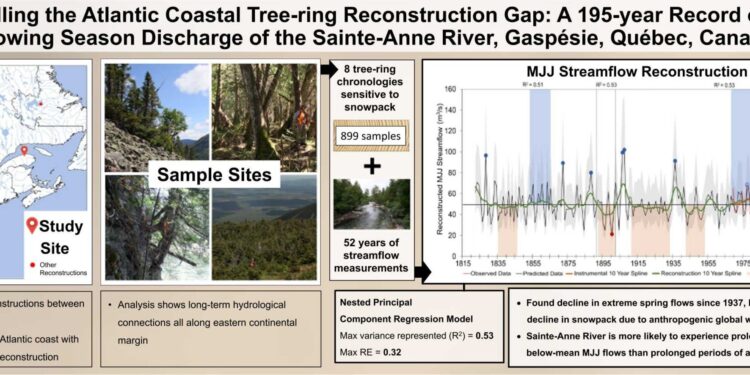Credit: Journal of Hydrology: Regional Studies (2025). DOI: 10.1016 / J.EJRH.2025.102229
A study of trees in the region of the Sainte-Anne de Gaspesie river reveals that snow pipes have decreased significantly in the region of the region for almost nine decades. Researchers say that the phenomenon is directly linked to global warming.
They add that the drop in the snowpack of the mountains of the Gaspesie National Park, which form the northern end of the Appalachian mountain range, has important implications for water management and regional fauna.
The study, led by Ph.D. the student Alexandre Pace and Jeannine-Marie St-Jacques, associate professor of the department of geography, planning and environment, is published in the Journal of Hydrology: Regional Studies. Concordia Ph.D. The student Duane Noel and Guillaume Fortin from the University of Moncton also contributed.
The researchers created a recording of trees from samples collected in the mountains, providing data dating from 1822. This extends historical knowledge far beyond the recordings established from instrumental readings, which only captured data from the mid-20th century.
Tree rings in the region can be a natural indicator of snow melting: finer rings are associated with springs that have late snow blanket, thicker rings with early thaw years.
“We found that large and extreme spring cast iron flows dropped after 1937, indicating a drop in winter snowpack in the mountains,” said St-Jacques. She adds that the presence of young forests moving on the slope is another longer indicator of longer growth seasons due to reduced snow blanket.
Two centuries of data
The samples of tree rings were collected on 13 sites around the intersection of chic-choc and mcgerrige ranges, in areas that have never been white cut by the forest industry. The samples were deducted in the summers of 2017, 2018 and 2019 from Cedars, Spruce and First, both alive and dead. The samples have been polite, digitized, digitally measured and crossed using specialized software to guarantee precision.
This complete study only does the Sainte-Anne river only the fifth river basin all over the North American Atlantic coast for its flow rate historically rebuilt according to the trees. The others are the Hudson, the Potomac, the Delaware and the South South Carolina.
The recordings of the Sainte-Anne river collected for this study align with the models of historical flows observed in the recordings of the other four, with synchronous eras of drought and strong precipitation.
“We can see that there are joint flow diagrams, whether at high or low levels,” she said. “In addition, if you look at the instrumental files, we see that the periods of low speed sustained are about as common as the high speed periods sustained. But if we return 200 years, we find that the periods of low speed are more common, suggesting that the water managers should plan lower periods, even in this wetland.”
Researchers note that understanding a large understanding of how northeast waterways of the northeast coast interact and share flow models can help authorities plan in the case of synchronous droughts in the future of more extreme climate models.
Advantages for humans and animals
Tree rings may contain indices on which Hydro-Québec relies on to plan major projects. The usefulness has made several reconstructions on the trees of trees for its hydroelectric projects of the La Grande river which flows in the Bay of James and the La Romaine project on the North Shore, emptying in the Estuary of Saint-Laurent.
But researchers point out that data from the Sainte-Anne river can also be useful in other respects. He can give more overview of the role of the drop in snow coverage in the decline of the population of Gaspesie Caribou, the only herd of the genre in the south of the Saint-Laurent estuary. It is also important for Atlantic salmon, which appears in rivers but has significant population threats in the southern parts of their range.
“This project highlights the importance of protecting old forests, because this allows us to have these chronologies from the longer trees of longer trees with which we can rebuild the climate and understand environmental change. They give a context to the changes that we see today,” concludes Pace.
More information:
Av Pace et al, filling the gap for the reconstruction of the coastal tree of the Atlantic: a record of 195 years of season of growth season of the Sainte-Anne, Gaspésie, Quebec, Canada, Canada, Journal of Hydrology: Regional Studies (2025). DOI: 10.1016 / J.EJRH.2025.102229
Supplied by Concordia University
Quote: The Rings of Gaspésie Mountains of Canada reveal the effects of global warming dating from almost a century (2025, April 1) recovered on April 2, 2025 from
This document is subject to copyright. In addition to any fair program for private or research purposes, no part can be reproduced without written authorization. The content is provided only for information purposes.



